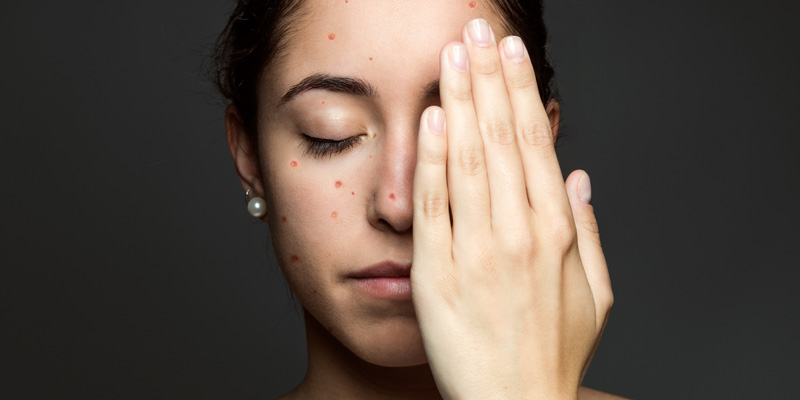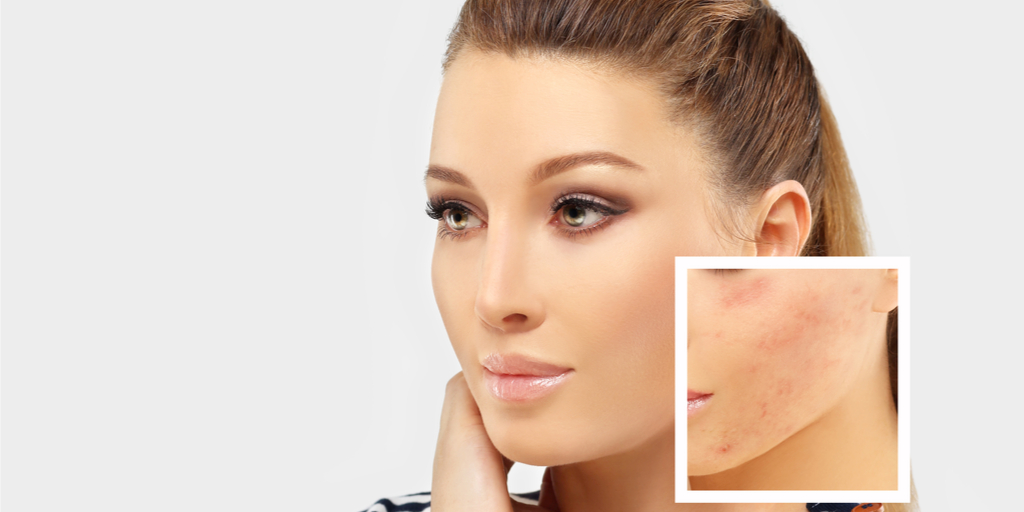In This Article
Chickenpox Scars Removal – Treatments And Home Remedies
Chickenpox is an infectious virus which affects almost everyone at least once in their lifetime.[1] Like other contagious diseases, the chickenpox virus settles down within 7-10 days. However, it may leave behind stubborn scars known as chickenpox scars. They mostly occur on face and can be so deep that it can take months to settle. Chickenpox scar removal treatments can treat these scars faster and more effectively. Read this article for details on how to remove deep chickenpox scars.
In This Article

Facts About Chickenpox Scars
The primary cause of chickenpox infection is exposure to varicella-zoster virus. If somebody gets affected by chickenpox, initial signs include the presence of itchy red papules on the body, progressing from vesicles on the stomach, back and the face, and then spreading to other parts of the face.[2]
There are two major factors that lead to chickenpox scars:
- Excessive scratching owing to itchiness. The skin gets deep wounds from aggressive rubbing.
- Inflammation of skin, leading to indented scars.
Like in the case of any other scar, the best time to treat chickenpox scars is immediately after they occur. As time passes, it gets harder to treat the scars which are prominent on the face, back and neck. Dermatological intervention will reduce the chances of permanent scarring.
Types of Chickenpox Scars
Not all of these scars are permanent, and many of them fade over time. Cosmetic intervention can even help treat permanent scars. Listed below are the two main types of chickenpox scars:
- Atrophic Scars: These pitted scars are caused by skin inflammation, where the collagen in the skin becomes damaged, causing improper healing and depressed scars.
- Light Round Marks: Compared to atrophic scars, these marks are less severe in nature and resemble post acne marks which may be light red or brown in colour. In a few cases, the scars are elevated from the surface of the skin.
Scars are common though not many know that based on the injury, they fall under different types. Watch this video to learn more about this:
Do Chickenpox Scars Go Away Naturally?
Light chickenpox scars fade gradually with time, but deeper scars stay longer unless treated medically. If your face, neck or back has scars from chickenpox, we recommend that you seek expert advice for the appropriate treatment and get smooth, scar-free skin.
How To Remove Chickenpox Scars?
There are several solutions – from unproven home remedies to advanced dermatological treatments – that reduce the appearance of chickenpox scars. But it is critical to identify the severity of the scars and get the appropriate treatment.
In the following sections, we cover all the available treatments for chickenpox scars.
NOTE:
Always speak to a dermatologist and discuss the nature and severity of your scarring to find out the most effective chickenpox treatment option for yourself.
Home Remedies For Chickenpox Scars
Here are some effective remedies to remove chicken pox scars at home:
-
Aloe Vera:
It is often considered a good agent for skin hydration and can help reduce the appearance of scars. You can apply some aloe vera gel on chickenpox scars and leave it to dry. The gel will help provide relief from itching too.
-
Vitamin-E:
For its anti-inflammatory properties, vitamin E-rich oils or creams can help heal skin. They can help smoothen the uneven skin.
-
Jojoba Oil:
Jojoba oil is rich in essential vitamins and minerals. Because it is non-comedogenic, it is known to be a good solution for healing marks.
-
Cocoa Butter:
It has good number of antioxidants and is considered a good moisturising agent for dry to extremely dry skin. Take a small amount of cocoa butter and apply it directly to the chickenpox scars. Let it dry for some time. Repeating this 2-3 times a day can help reduce chickenpox scars.
-
Argan Oil:
It is said to have anti-ageing properties and can be used both topically and orally to improve the overall health of skin. It can help treat chickenpox scars and promote smoother and even skin.
-
Coconut Oil:
It is a good moisturising agent and has skin-healing properties. You can dip a cotton ball in coconut oil and dab it gently on chickenpox acne scar. It reduces skin itchiness, prevents rashes and is known to make the skin supple and smooth.
-
Shea Butter:
It contains omega-3 fatty acids good for treating acne marks and skin moisturisation. Gently massage the affected area with some Shea butter. It will reduce itchiness and hydrate the skin.
DISCLAIMER:
Natural remedies like aloe vera, Vitamin E, Jojoba oil, Cocoa butter, Argan oil, and Shea butter are said to help reduce chickenpox scarring. It is important to note that though these home remedies may provide some relief, they are not a long-lasting and suitable solution for chickenpox scars. Further, home remedies do not have the same effect on everyone. Therefore, always consult your dermatologist before trying them.
Over The Counter (OTC) Treatments For Chickenpox Scars
The market is full of topical agents that claim scar improvement properties. When you look for OTC products specific for chickenpox scar removal, find products with specific ingredients like Retinol and Glycolic acid, which are common in creams and ointments for acne scars.
The following OTC options for chicken pox scar removal:
-
Retinoids:
Tretinoin (Retin-A), adapalene (Differin) and tazarotene (Tazorac) are commonly available retinoids. They can help in collagen production.
-
Exfoliants:
These chemical agents can remove the top layer of the skin and reduce the appearance of chickenpox scars.
-
Topical Creams:
Various topical creams containing glycolic acid, lactic acid or mandelic acid or AHAs are available to stimulate collagen production in the skin.
-
Silicon Sheets:
Thin silicon sheets infused with vitamin E or other natural ingredients can be placed on the skin to relieve itching and dryness.
NOTE:
Always consult an expert dermatologist to find which of these OTC products will best suit your skin type and concern.
Best Cream For Chickenpox Scar Removal
Here are some cream options that can help reduce the appearance of chickenpox scars, but make sure you consult an expert dermatologist before using any of them so you get the desired results without the fear of side effects.
-
Medicated Creams:
Dermatologists may recommend a few over-the-counter or prescription creams containing skin-healing ingredients like hydroquinone, retinoids or alpha hydroxy acids (AHAs).
-
Vitamin E Cream:
Vitamin E is a good agent for reducing the visibility of scars and making the skin look smoother.
-
Onion Extract Creams:
Creams containing onion extract may help improve skin after the scars.
-
Corticosteroid Creams:
Dermatologists may prescribe specialised corticosteroid creams for treating chickenpox acne scars.
Best Treatments For Chickenpox Scar Removal
-
Laser Resurfacing:
Laser treatment for chickenpox scars removal is one of the most trusted methods available in reputed skin clinics. In this procedure, the expert exposes the scar tissue to a medium or high-intensity energy beam. The dermatologist performing chickenpox scars treatment ensures that the intensity of the laser device is carefully controlled to avoid damaging the surrounding healthy skin tissue. The laser resurfacing treatment helps lighten the colour of old scars, improves its sunken appearance, and makes it less visible.[3] One may need 4-6 sessions of the treatment depending upon the number and severity of the scars. The treatment is non-invasive and has no downtime.
Watch this video to learn more about Laser skin resurfacing treatment procedure to get rid of chicken pox scars:
-
Chemical Peeling Treatment:
Chemical peels for chickenpox scar treatment work by removing the surface layer of the skin, which may help to fade the colour and depth of the chickenpox scars. Some common agents used are alpha hydroxy acids, beta hydroxy acids, and a combination of both (e.g., TCA Cross peel). This is a quick chickenpox scar removal treatment with no downtime and is often used in combination with other scar removal treatments.
Watch this video to learn more about chemical peel treatment:
-
Subcision Surgery:
If the chickenpox scar is large, deep and tethered, then your dermatologist may suggest subcision, which is a slightly invasive procedure for chickenpox scars removal. The treatment involves the application of local anaesthesia to the target area. Experts use needles to release the base of the scarred skin tissue, drastically reducing the depth of the scar. Subcision for chickenpox scars is combined with micro-needling or dermal fillers. The treatment may have a downtime of 2-4 days.
-
Microneedling Radiofrequency (MNRF):
Microneedling is one of the safest treatments available for chickenpox scars. In this procedure, radiofrequency energy is deposited in the deeper layers of the skin through tiny needles, which trigger collagen production. The chickenpox scar begins to elevate with the induction of new collagen beneath the skin. This method is combined with other techniques like laser resurfacing for longer-lasting results. The treatment may have a 24-hour downtime.
Watch this video to learn more about Mirconeedling Radiofrequency treatment procedure to get rid of chicken pox scars:
-
Surgical Procedures:
Surgical chickenpox scar removal procedures are ideal if you want a more aggressive approach and a quicker solution. In the punch excision method, experts surgically remove the chickenpox scar tissue and then stitch the area leaving a fine, aesthetic scar. Surgical correction is another approach wherein they perform skin grafting by using healthy tissue from other body areas and fill the deeper scars. This invasive treatment may have a downtime of about 7 days.
-
Dermal Fillers:
Dermal fillers work by raising deep or depressed chickenpox scars using various fillers, one of them being hyaluronic acid. Treatment of deep chickenpox acne scars using dermal fillers as stand-alone option isn’t as effective so experts combine it with other treatments. Depending upon the size of target area and number of chickenpox scars, this treatment may take from 15 mins to 1 hour.
-
Microdermabrasion:
This is a minimally invasive treatment for chickenpox scar removal. A special applicator with abrasive surface is used in the target area with chickenpox scars. This treatment exfoliates the topmost layer of the skin triggering the growth of new skin cells. It may have a downtime of about 24 hours.
-
Fillers:
After assessing the depth and severity of the scars, the dermatologist may recommend special fillers as a combination treatment for chickenpox scar removal. The fillers made with collagen or special chemical agents, even out the pits in the skin. The dermatologist injects the fillers under the surface of the skin using specialised needles. The treatment doesn’t have any downtime.
-
Scar Excision And Punch Excision:
It is a minimally-invasive chickenpox scar removal treatment that utilises a specialised tool to punch around the scar, thus removing it. After the punch method, the treated area may develop tiny hole which will need a small suture. The dermatologist uses local anaesthesia and it requires a downtime of 2-4 days.
-
Skin Grafting:
It is a surgical chickenpox scar removal method. Experts use general anaesthesia. The treatment involves taking healthy skin from any part of the body and grafting it into the areas with deep chickenpox scars. The downtime may vary from 5 to 7 days.
How To Prevent Chickenpox Scars?
To prevent chickenpox scars, one must take care of the following important points:
-
Avoid Scratching:
While scratching can offer temporary relief, it can leave wounds on the skin that can lead to permanent scarring.
-
Use Sunscreen:
Applying a broad-spectrum sunscreen can prevent the scars from darkening and reduce their appearance.
-
Keep Moisturising:
Keeping the skin moisturised and hydrated can help reduce the number of deep and severe scars.
-
Try Antihistamines:
Some people who took OTC antihistamines reported ease in itchiness of chickenpox. (Make sure you consult a doctor before taking these medicines.)
-
Wear Loose-fitting Cotton Clothing:
Wear comfortable and loose-fitting clothing to avoid irritability.
-
Cleanse The Affected Area:
Keep the area clean to avoid infection and for the pox to reduce faster.
-
Soothe The Itch:
You can gently dab a cotton cloth on itchy areas to sooth the itch.
How Much Does Chickenpox Scar Removal Cost In India?
The cost of chickenpox scar removal treatment using OTC products can range from INR 1000 to 5000, whereas medical treatments for deep and severe scars may cost from INR 5000 to 18000. The price of treatment varies based on factors such as the size of the area to be treated, the number of scars to be treated, their severity, the number of sessions required for the treatment, the type of treatment needed, the dermatologist’s expertise and the reputation and location of the clinic.
Chickenpox scar removal pricing:
| Chicken Pox Scar Treatment | Minimum Cost (INR) | Average Cost (INR) |
| Laser Treatment | 5000 | 18,000 |
| Chemical Peel | 4500 | 12,000 |
| MNRF (Micro Needling) | 4500 | 20,000 |
| Subcision | 10,500 | 21,000 |
| Dermal Fillers | 15000 | 35,000 |
| Dermabrasion | 3900 | 7,500 |
| Scar Exicion Surgery | 10,000 | 35,000 |
Chickenpox virus is harmless and mostly affects everyone. However, the fact that this condition can leave permanent and deep scars on the skin makes it a little concerning. The market is full of OTC products to heal scars, and the internet is full of home remedies—but remember that the best way to deal with scars, with safety and precision, is to consult an experienced dermatologist.
DISCLAIMER:
Please note that the prices mentioned are indicative and may vary depending on the specific treatment, choice of technology, and underlying skin or hair conditions. Prices are also subject to change based on ongoing promotions or offers at the clinic. For an accurate estimate, please consult with our dermatologist.
Frequently Asked Questions On Chickenpox Scar Removal Treatment
Fading deep chickenpox scars naturally can be tricky. Home remedies like aloe vera and vitamin E are helpful, but their effectiveness still needs to be guaranteed. Talk to a dermatologist if you’re looking for significant improvement, especially for deeper scars. They can offer options like laser treatments or microneedling that target scar tissue more effectively.
Reducing chickenpox scars starts with avoiding scratching during chickenpox outbreaks. Once healed, tackle existing marks with moisturizing creams or natural remedies like aloe vera. For stubborn scars, a dermatologist can offer targeted solutions.
Creams containing alpha hydroxy acids (AHAs) like glycolic acid or lactic acid can gently exfoliate the top layer of skin, promoting cell turnover and potentially reducing the appearance of chickenpox scars. Retinoid creams, available over-the-counter in lower strengths, can also stimulate collagen production, which may help improve scar texture. It’s important to note that these creams are safe to use, but the effects tend to be subtle and take consistent use over a long period. For better results and to avoid side effects, it’s always advisable to consult a dermatologist.
When it comes to chickenpox scars, there’s no one-size-fits-all treatment. The best approach depends on the scar’s depth and characteristics. Dermatologists offer a comprehensive range of treatments to address chickenpox scars, including Laser treatment, chemical peels, microneedling, and surgical procedures. Depending on the severity of your scars, a dermatologist will recommend the best treatment plan for you.
Yes, once the virus’s impact decreases, the chickenpox is gone, leaving behind chickenpox scars.
Mild scars can go away without much intervention. However, moderate to deep scars may need medical attention or they will become permanent.
There is no scientific evidence proving this. It is best to consult a dermatologist for a customised treatment plan.
Yes, Some people may find applying coconut oil soothing, but it may not work for everyone. Further, there is no guarantee that it can reduce the chickenpox scars.
No study can back this claim. Your dermatologist can recommend effective topical creams or suitable treatments that can help reduce scar appearance.
Not all chickenpox scars are permanent. They can range in size and severity. The deep and severe chickenpox scars can become permanent if you don’t get timely, appropriate treatment. With proper care and medical intervention, you can reduce their appearance.










